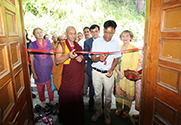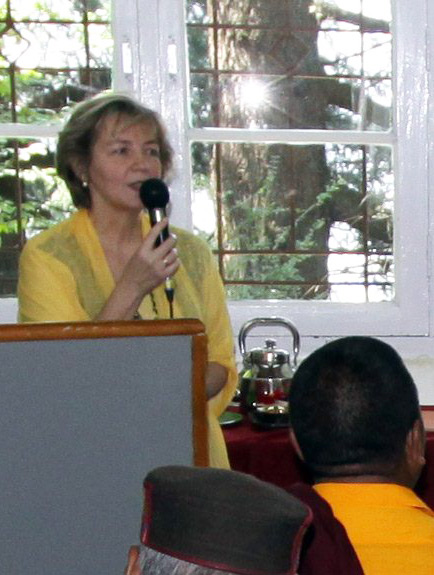
|

|
On August 16, 2017, the International Roerich Memorial Trust (IRMT), Naggar, conducted a festive programme on the occasion of the 115th anniversary of George Roerich, the renowned orientalist, Buddhist scholar, linguist and explorer of Central Asia, and the elder son of Nicholas and Helena Roerich. As per tradition, representatives of the Buddhist world were the chief guests of the programme.

|
|
|
The ceremony "Lama Choepa"
|
|
Festivities opened with the Lama Choepa, the ceremony in honour of one’s Guru (the Tibetan analogue of Guru Puja) conducted by the lamas of the Pangang Buddhist Monastery located on the opposite bank of the Beas, on the hill slope overlooking the IRMT. The ceremony took place in the George Roerich Hall, Administrative Building, ‘Urusvati’ Himalayan Research Institute, adjacent to the George Roerich Memorial Study. Both the Hall and the Study were opened this spring with the active support of the International Centre of the Roerichs, Moscow, Embassy of the Russian Federation in the Republic of India, New Delhi, the friends of the IRMT from Delhi, as well as the government of Himachal Pradesh and Russian guests. The Hall and the Study display the items connected with the life and work of George Roerich that still bear his touch. Among the exhibits, one can see the statue of the great reformer of Tibetan Buddhism Tsongkhapa; the picturesque Chinese cups and vases covered with enamel; the cards with linguistic and historical information; and some publications and translations including the original edition of the seminal Tibetan treatise Blue Annals. These surroundings created a particularly solemn atmosphere and the impression of George Roerich’s true presence.
After the ceremony, the guests were welcomed to the rooms of the “Urusvati” Institute Research Library in the Laboratory Building of the Institute for the seminar “George Roerich as a Buddhist scholar”. It was for the first time in many years that an academic seminar was held within the walls of the Institute. Surrounded by the bookcases and shelves filled with old books and magazines collected by the Roerichs themselves, the participants of the seminar were transferred, as it were, to the time when the Institute founded by the great Russian family in the remote corner of the Himalayas was an actively functioning research center meant to combine the achievements of modern science of the West and the spiritual knowledge of the East.

|
|
|
Mrs. Larisa V. Surgina
|
|
|  |
|
Mr. Ramesh Chander
|
In their welcome address to the participants and guests of the seminar, Mrs. Larisa V. Surgina, Russian Curator, IRMT, and employee of the International Centre of the Roerichs, Moscow, and Mr. Ramesh Chander, Indian Curator, IRMT, noted the tremendous role of Buddhism in the history and culture of Greater India and underscored the invaluable contribution of George Roerich to Buddhist studies and exploration of the Central Asian region.
Dr. Alexander Pereverzev, Asstt. Russian Curator, IRMT, and the employee of the International Centre of the Roerichs, Moscow, gave a brief survey of the publications on Buddhism kept in the ‘Urusvati’ Institute Library. The Library houses a great number of books on Buddhism including the works by such Buddhist luminaries as Anagarika Govinda and Anagarika Dharmapala, researches by Western Buddhist scholars and explorers of Central Asia like the renowned traveler Sir Aurel Stein, such fundamental Buddhist texts as Dhammapada and Prajna Paramita Sutra, several Tibetan manuscripts including those of the Kalachakra and Guhyasamaja Tantras, etc. The Library is also well stocked with Asian and European Buddhist periodicals of 1920s-1940s including The Buddhist, The Mahabodhi, The Buddhist World, etc.
 |  |
|
Dr. Alexander Pereverzev
|
Participants of the seminar “George Roerich as a Buddhist scholar”
|
Showing lively interest and excitement, the guests browsed through some of them and held in their hands some of the works by George Roerich himself: the original edition of his translation of Blue Annals (1949), the medieval treatise that traces the development of Buddhist doctrines in Tibet; his monograph The Tibetan Dialect of Lahul (1933); and his article The Ceremony of Breaking Stone (1932) published in the 2nd and 3rd volumes of the ‘Urusvati’ Institute Journal.
| 
|
|
Mr. Yeshe Tsering
|
Mr. Yeshe Tsering, Thangka Teacher, Tibetan Children’s Village School, Patlikuhal, briefly traced the history of Buddhism in Tibet and made a survey of the major schools of Tibetan religious painting such as Menri and Karma Gadri. He also noted that the Buddhist scholar Gendun Ghophel cooperated with George Roerich for several years in translating Blue Annals into English.

|
|
|
Ven. Jurme Dorje
|
|
Ven. Jurme Dorje of the Pangang Gompa spoke on the history of that place. In 1963, the renowned scholar of the Nyingma tradition Khanpo Rinpoche chose the place overlooking the Beas to live in seclusion and practice. His presence there over time drew disciples from the close-by Buddhist Himalayan regions of Ladakh, Lahaul, Spiti and Kinnaur. Gradually the gompa was constructed and at present it is home to several monks and some 40 nuns. On the cremation site of Rinpoche, who left for his heavenly abode around 20 years ago, a stupa has been erected. The monastery has completed the construction of a school building where the young generation will acquire the profound knowledge of Buddhist teachings.
|  |
|
Mr. Tsering Dorje
|
The renowned Lahauli Buddhist scholar and the expert on the Tibetan language and culture Mr. Tsering Dorje dwelled in detail on George Roerich’s contribution to Lahaul studies. In Lahaul, George Roerich conducted archeological excavations, studied local dialects, rituals and folklore, including the archaic pre-Buddhist ritual songs in the ancient Tibetan language (Jangjung), which were later published in one of the volumes of the ‘Urusvati’ Institute Journal. George Roerich also initiated the copying of the manuscript of the Tibetan epic of Gessar Khan, which he studied later. Even today the ledgers with the copied manuscript are preserved in the IRMT.
Due to Tsering Dorje’s persevering effort, the state government has allocated funds for the restoration of Nicholas Roerich’s studio in Lahaul, and the speaker gladly told the gathering about the progress of restoration works and his plans of making a museum in the studio building. It is noteworthy that Mr. Tsering Dorje was one of the disciples of the founder of the Pangang Monastery Khanpo Rinpoche.
The academic part was followed by the grand opening of the exhibition “The Living Tradition of Buddhist Painting” displaying the thangkas painted by the students of the Tibetan Children’s Village School, Patlikuhal, under the guidance of their mentors. In the exhibition, one could see the images of the Buddha, Padma Sambhava, White Tara, Manjushri and other members of the Buddhist pantheon. “The most characteristic samples of Tibetan pictorial art,” writes George Roerich in his work Tibetan Paintings, “are the so-called thangkas usually translated as “banner”. These thangkas are found in large numbers in the temples and private houses. They are always carried in religious processions and often used as illustrations in religious ceremonies. Travelling lamas sometimes carry along with them a good collection of these paintings, which help them in preaching, since the art in Tibet and other lamaist countries has been closely connected to the propaganda of Buddha’s teaching.” Interestingly, while analyzing the context of thangka painting and its technique, George Roerich remarks that there is a great similarity between the methods used by the Russian and Tibetan icon painters. “Indeed,” he writes, “it seems that the Russian and Tibetan fine art borrowed their method from a common source.”
In continuation of festivities, the teachers and students of the Helena Roerich Academy of Arts for Children managed by the IRMT, Naggar, delighted the guests with a beautiful cultural programme, which opened, in accordance with tradition, with the prayer to the goddess Sarasvati. Senior girls performed the classical Indian dance, Kathak, while the juniors wearing the bright colours of India’s flag performed the dance dedicated to India’s Independence Day celebrated the day before. On the same occasion, the boys performed the patriotic song “Rise, India, Rise!” As a closing note of the cultural programme, the teacher of vocal Pushpa Devi beautifully rendered the famous Buddhist chant “Buddham Saranam Gacchami”.
 |  |
|
On the exhibition “The Living Tradition of Buddhist Painting”
|
Students of the Helena Roerich Academy of Arts for Children
|
The festivities closed with one more event: inauguration of the children’s painting exhibition in the Devika Rani Gallery in the premises of the IRMT Cultural-Educational Centre. The visitors of the exhibition highly appreciated the effort of the young artists – the students of the Academy of Arts for Children – to depict Himalayan landscapes, capture certain aspects of traditional Indian culture and come up with original interpretations of Nicholas Roerich’s paintings.
The gala event that took place in the Himalayan estate of the illustrious Russian family of artists, thinkers and scholars on the occasion of the anniversary of George Roerich, has contributed to the strengthening of Indo-Russian cultural relations. It was one more event in the framework of the festival “Russia-India-the Roerichs” marking the 70th anniversary of Russian-Indian diplomatic relations and the 25th anniversary of the International Roerich Memorial Trust.
|











